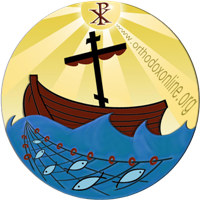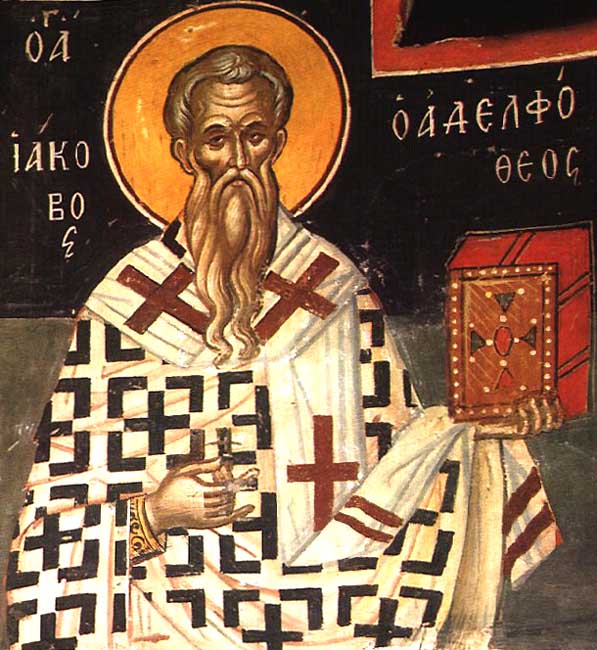 The Church commemorates him on October 23. He is not the Apostle James, son of Alphaeus, one of the Twelve. The Gospel mentions him as one of the four brothers of the Lord Jesus, the other three being Joses, Simon, and Judas (Matthew 13:55 and Mark 6:3) who did not believe in him at first (John 7:5).
The Church commemorates him on October 23. He is not the Apostle James, son of Alphaeus, one of the Twelve. The Gospel mentions him as one of the four brothers of the Lord Jesus, the other three being Joses, Simon, and Judas (Matthew 13:55 and Mark 6:3) who did not believe in him at first (John 7:5).
As for the relation of these brothers to the Lord Jesus, it has had, from the beginning, more than one interpretation: according to some interpreters, they were the sons of Mary’s sister, or according to some they were the sons of Joseph, and these are brothers in Jewish tradition. The second interpretation – which is the most common in heritage – is that they are the sons of Joseph from a previous marriage, because the ancients believed that Joseph was a widower when he married Mary.
As for them being the children of Joseph and Mary together, this is not possible because there is no text that says that, and for other reasons, including that two of them were the children of Mary, the mother of James and Joses, who was among the women who were looking from a distance at Jesus being crucified, “and among them were Mary Magdalene, and Mary the mother of James and Joses, and Salome” (Mark 15:40).
We also know that the word brother has several meanings for the Jews other than physical kinship. An example of this is in the Book of Genesis where it is mentioned that Abraham was Lot’s uncle (11:27) and in another place that Abraham was Lot’s brother (14:16). A brother is a relative in general. And in the Gospel of John, “And there were standing by the cross of Jesus his mother, and his mother’s sister, Mary the wife of Cleopas, and Mary Magdalene” (19:25). So how can there be two sisters with one name?
James is the author of the general letter written in the New Testament and known by his name, which begins, “James, a servant of God and of the Lord Jesus Christ, to those who believe…” The Apostle Paul mentions him in his letter to the Galatians 1:19, which we read today on his feast day: “…I went up to Jerusalem to see Peter, and stayed with him fifteen days. And I saw none of the apostles except James the Lord’s brother.” From this we understand that he had an important position among the apostles.
In the Book of Acts of the Apostles, we read in the fifteenth chapter, when the apostles and elders gathered to consider the matter of circumcision and answer the question: Should everyone who believes in Jesus from the nations be circumcised or not? On that day, James stood as the head of the congregation in Jerusalem, and said the decisive word, and the apostles agreed upon it.
The apostles chose him as the first bishop of Jerusalem - as we know from heritage - and he pastored it for thirty years, preaching to the Jews and the Gentiles and bringing them to Christ. The Jews hated him, and while he was preaching from a high place, the scribes and Pharisees pushed him and he fell to the ground and one of them struck him, so he died a martyr.
The liturgy of the “Mass of Saint James, the Brother of the Lord” is also attributed to him, which scholars believe dates back to the late fourth or early fifth century, and that it is considered the main source for the Mass of Basil and the Mass of Chrysostom, but it fell out of use in the late twelfth century. It is worth noting that this service is held once a year in the Church of Jerusalem on the day of his feast.
This is the most important thing we learn from the New Testament about James the Apostle, the brother of the Lord. As for what is commonly known about him, other than that, it belongs to the heritage. In the heritage, it is said that he was known as James the Righteous, that he was a Nazirite from childhood, that he remained chaste until the end of his life, and that he was content with the least food, and that he often spent his nights in prayer until his knees became like stones from so much prostration. The apostles unanimously chose him as the first bishop of Jerusalem, and he was his for thirty years. The oldest liturgy is attributed to him, “The Liturgy of Saint James the Apostle,” which scholars believe is the origin of the liturgy of both Saints Basil the Great and John Chrysostom. It has been said that he brought many, Jews and Gentiles, to faith in Christ, so the Jews hated him and decided to get rid of him.
Saint Jerome said about him: He preached the Gospel to the twelve tribes of Israel in the diaspora. And in the tradition of the Church in Spain, it is said that James preached there.
Once he preached to the people from the roof of a house or perhaps from the wing of the temple, and the scribes and Pharisees came and threw him from a height. He fell to the ground and was injured, but did not die. However, a possessed man struck him with a stick on the head, which killed him. He slept in the Lord as a martyr at the age of sixty-three. This was in the year 62 AD. Later, devout Jews spread the rumor that the siege and destruction of Jerusalem in the year seventieth was a punishment from God for his murder.
Troparia in the third tune
O holy Apostle James, intercede with the merciful God, that He may grant forgiveness of our sins to our souls.
Qandaq with the second tune
When you heard the divine voice calling you, you turned away from your father’s love and hastened towards Christ with your brother, O glorious Jacob, and you were worthy to see with him the manifestation of the divine Lord.


